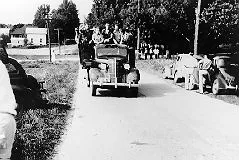By Tom Kriger
A familiar refrain is playing out throughout the dairy industry in the United States. Prices are down, the press has picked up the story of discontent in the dairy states and discovered yet another dairy “crisis” and the long term trend where the number of producers continues to decline has accelerated, in the face of recession, overproduction, and lack of meaningful government action.
In New York State, one of the leading dairy states, the situation may be the worst in 30 years. In 2008, New York farmers received $25 per hundredweight for their milk – a record at the time – but farm prices have fallen by more than 50 percent since then, leading both farmers and policy makers to fear a wave of foreclosures and bankruptcies in the near future.[i] In Europe, the situation is much the same; producers have petitioned the EU agricultural ministers for quick intervention to address overproduction and falling dairy prices.[ii]
With dairy farmers pushed to the brink – in what has become a seemingly regular occurrence over the past 30 years – one of the most interesting questions concerns their response to the latest crisis. As they have for years, dairy famers’ have conducted a series of meetings with policy makers in various states and nations, sometimes supplemented with a well-mannered protest demonstration. But they have largely chosen to work within a system that has failed them often across this period. This is a far cry from the response of dairy farmers during the last global economic crisis of this magnitude, when farmers took to the streets and engaged in civil disobedience in pursuit of their economic and political goals.
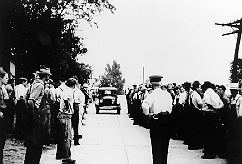
During the Depression in the United States in the 1930s, disruptions and civil disobedience were typically associated with organized labor,although it’s important to remember that farm strikes or “holidays” also played an important role in shaping New Deal politics and the creation of the dairy price support system. By 1931 a large and angry agrarian insurgency had emerged in the Plains states. The largest and most infamous farm strike organization was Milo Reno’s Farmers’ Holiday Association. This group of prosperous and usually quiescent Corn Belt farmers pressured the Roosevelt Administration to address the escalating crisis in the American Mid-West with a series of “holidays” or farm strikes in 1933. What is less well known is that dairy farmers were the driving force behind the early farm holiday movement. There were “milk wars” in St. Louis and central Illinois in 1931, and “holidays” in the Houston, Sioux Falls, Atlanta, Chicago and Indiana milk markets in 1932.[iii]
The largest Midwestern milk strike was the Sioux City Milk War of 1932, which served as a catalyst for the Farmers’ Holiday strikes. The issue that sparked this conflict was the “spread” between retail and farm milk prices in Sioux City, Iowa. Similar to the situation today, dairy farmers received just two cents per quart from local processors, while consumers paid eight cents per quart in Sioux City. The Sioux City Milk Producer’s Association ‑ whose membership overlapped with the Farmers’ Holiday Association ‑ called the strike, which was settled only after violence and mass arrests. At one point three thousand farmers marched on the jail at Council Bluffs, Iowa, forcing the local Sheriff to release their fellow strikers.[iv]
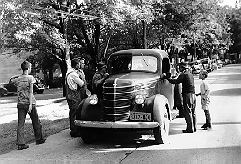
In New York State, the Depression hit dairy farmers equally hard. Dairy producers reeled under the combined effects of the same forces that had produced the Midwestern strikes: decreased demand for milk and low farm milk prices. Like their Midwestern counterparts, with technological advances New York dairy farmers had greatly increased their capacity to produce milk. Further, a wave of retail price cutting swept through the New York City milk market in the early 1930s, which had a negative impact on both farmers and milk dealers. As a result of this cutthroat competition, market relations nearly collapsed. According to the New York State Milk Control Board:
Prices paid for milk had fallen to such a low level that dairymen could not possibly meet their most pressing obligations. Even the bare necessities of life could not be secured by many farm families, and many dairymen were threatened with the loss of the farms and homes in which their meager lifetime savings were invested.[v]
In April 1933, a large group of dairy farmers in western and central New York organized a four-day strike in order to force the state legislature to implement price controls. In August 1933 farmers organized a larger and more confrontational strike in protest against the State’s Milk Control Board, which had been created by the State Legislature after the April strike. By August, farmers’ opinion of the Milk Control Board had soured. They charged that the Board’s price fixing had favored corporations and their associated co-ops at the expense of farmers. As a New York Times reporter concluded, the 1933 strikes “possibly. . . brought New York State closer to marshal law than at any time since the Revolutionary War.”[vi]
In 1937, a new group called the Dairy Farmers Union (DFU) organized yet another strike after farm milk prices hit their lowest level in fifteen years. The leader of the DFU was Archie Wright, a former organizer for the Industrial Workers of the World (IWW), who drew upon the language and tactics of organized labor and the farmers’ penchant for direct action to gain greater political and economic power. The key for Wright was to effectively harness the energy of farmers’ discontent and channel it into a more effective political force.
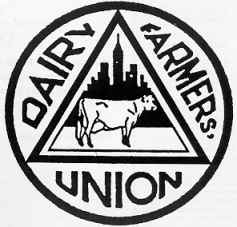
In July 1937, the DFU organized a regional strike in Northern New York, which was later expanded statewide, in an attempt to halt the flow of all milk into New York City, the nation’s largest milk market. Although many farmers saw no price increase after the strike, one important lesson DFU farmers learned was that given sufficient organization and planning, milk strikes could be an effective weapon.
In 1939, the DFU organized the largest and most successful milk strike in state history. That year, the dairy industry was again thrown into turmoil following a federal court decision which declared unconstitutional New Deal regulatory controls enacted in New York. In August 1939, 15,000 DFU farmers from northern New York, the Mohawk and Hudson River Valleys, and Northern Pennsylvania and Western Vermont, voted to begin picketing and diverting milk.
By the strike’s third day, the DFU had tightened its grip on the New York City milk supply with only scattered incidents of violence. The Union’s
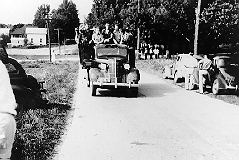
ability to quickly accomplish this goal was due to two important factors. First, discontent ran so deep among the “rank and file” in 1939 that many farmers who were not DFU members joined the strike either by refusing to deliver their product or by arranging for DFU pickets to dump their milk. Second, sympathetic public opinion in the strike region and DFU allies such organized labor proved important in completing the Union boycott of upstate milk plants. Union leaders such as the United Mine Workers’ John L. Lewis sent telegrams of support, while the Transport Workers Union dispatched an organizer to help Archie Wright.[vii]
With the New York City milk supply cut by as much as sixty percent by the strike’s third day, the DFU received assistance from New York City Mayor Fiorello LaGuardia. Hoping to avoid a milk shortage, the Mayor called on the DFU and major co-ops and dealers to send representatives to a conference at the World’s Fair Grounds in Queens, where he hoped to broker an end to the strike. On the strike’s ninth day, Wright signed a strike settlement in which the large milk dealers agreed to increase farm milk prices and to recognize the DFU. Farmers, editors, and merchants hailed the DFU’s triumph across upstate New York. The Watertown Times pointed to “the overwhelming public support that the farmers received in their strike” as a significant factor in the Union victory, and added:
“. . .The Dairy Farmers’ Union emerges on top. In few short years it has become the dominant organization throughout the entire milk shed. And why should this not be so? The union was formed as an organization of producers for the benefit of producers.”[viii]
In the months after the 1939 strike, the milk dealers and their allies red-baited Wright and attacked the DFU as un-American. Over the next few years, these attacks on Wright and the DFU eventually succeeded in splitting the Union and limiting its political and economic power. Technological changes in the dairy industry also made it more difficult for farmers to strike. Bulk tanks and farm pick-up meant that striking farmers could no longer block the local milk plants, which were consolidated and enlarged.
The central question in this most recent international dairy crisis is whether farmers’ well-mannered attempts to work within the political system will find success in stabilizing prices and limiting the decline in their numbers. Or, will farmers turn to disruption if this doesn’t work? Today, farmers are atomized, isolated and far fewer in number (especially when compared to the 1930’s), and perhaps more likely to view themselves as business people than protest movement participants. What remains to be seen is whether dairy farmers’ lobbying efforts can help mitigate the effects of the latest crisis.
Notes
[i] Chris Churchill, “Losing Money, but Hanging On”, Albany Times Union, 2 October 2009, www.timesunion.com/ASPstories/story.asp?LinkFrom=RSS&StoryID=848518.
[ii] Luc Vernet, “Milk Crisis Back on Ministers’ Agenda,” 16 October 2009, Europolitics, www.europolitics.info/sectorial-policies/milk-crisis-back-on-ministers-agenda-art251450-11.html.
[iii]. See New York Times, for St. Louis: 8 November 1931, 6; 15 November, 25; central Illinois: 31 October 1931, 5; Houston: 15 February 1932, 3; Sioux Falls (SD): 1 September 1932, 3; Atlanta: 24 September 1932, 32; 25 September, 16; 27 September, 1; 28 September, 21; 29 September, 15; Chicago: 17 July 1932, 15; Indiana: 20 September 1932, 15.
[iv]. For the Sioux City Milk War, see New York Times, 14 August 1932, 8; 15 August, 14; 16 August, 2; 18 August, 42; 19 August, 19; 20 August, 28; 21 August, 7; 30 August, 36; 1 September, 1; for the Farmers Holiday Association strikes, see John Shover, Cornbelt Rebellion (Urbana: University of Illinois Press, 1965); Dale Kramer, The Wild Jackasses (New York: Hastings House, 1956), 224-41; Arthur M. Schlesinger, Jr., The Age of Roosevelt, Vol. I, The Crisis of the Old Order (Boston: Houghton Mifflin, 1956), 266-67; Studs Terkel, Hard Times (New York: Pantheon Books, 1986), 213-29.
[v]. New York State, Milk Control Board, Report of the Milk Control Board to the Governor and the State Legislature (Albany: J.B. Lyons, March, 1934), 3.
[vi]. New York Times, 13 August 1933, Section 4, 1.
[vii]. The Union Farmer, 25 September 1939, 1; Lowell K. Dyson, Red Harvest (Lincoln: University of Nebraska Press, 1982), 172-3.
[viii]. Watertown Daily Times, 22 August 1939, 4.

